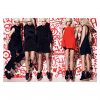Warning: Undefined variable $listtag in /home/storage/752/3595752/user/htdocs/wp-content/plugins/image-gallery-reloaded/image-gallery-reloaded.php on line 202
Deprecated: preg_replace(): Passing null to parameter #3 ($subject) of type array|string is deprecated in /home/storage/752/3595752/user/htdocs/wp-includes/formatting.php on line 4810
The friend who is always there for us, the girl next door, the regular worker and the model citizen. All of them are images of ‘normal’ people whom we can identify with and the perfect translation of the Every Person archetype: a realistic, empathetic, no-fuss kind, always looking for companionship, since its basic desire is to connect with others.
The archetype has been in high demand in our culture, especially with the rise of social media giving voice to everyone and their mothers. Facebook and Twitter are the best examples. Airbnb and Uber also show how we can make services more accessible to a lot of people and IKEA brings affordable design to the masses. In fashion, the normcore trend and the rise of casual clothes that can be worn almost anywhere shows the power of the archetype. GAP was a great example with its ‘basics for everyone’ message but lost its touch when they tried to catch up with European fast-fashion chains. Now, Uniqlo has taken their space. Glossier is a fantastic example in the beauty industry with its approach of skincare and makeup products crowdsourced from the feedback they get from readers.
On the other hand, we need to address the paradox being faced right now because the Every Person represents our longing to fit in although we are constantly stimulated to stand out in the crowd and show our individuality – everybody wants to be an internet star. So, how we balance it? If you want to work with the symbol bear in mind that you need to above all unite people, strengthen the sense of community and equality without erasing their voices or overlooking their needs, otherwise they feel left out and may become bulliers, which is the archetype shadow.
Nevertheless, it can work for brands willing to explore collaborative models, support local manufacturers or invest in a more ‘normcore’, less trendy style. It’s worth noting that the biggest opportunities appear when we understand what is behind the surface in terms of market and consumer needs and touch the emotional side. Once you get it, you no longer sell a simple product but create a real connection between brand and clients!






